|
1st INTERNATIONAL
MAIL ART EXHIBITION Galeri Seni, FSSR, UiTM, Shah Alam, MALAYSIA
Mail
art, as its name indicates, is an art that is delivered via mail. Mail art conveys messages, which are more individualistic
in manner. It can be regarded, as art that moves through mail as its medium. This collection of art works comprises of drawings
or images created by rubber stamp printing, collage, sketches or illustrations on envelopes, postcards, photocopy, poems,
sketches, computer printouts, stamps, stickers and other forms of art, as long as they are delivered via mail. Some people
even say that if a stone could be mailed and its recipient received it, it could also be called mail art. One of the most
important principles for a mail art artist is that a sender must also receive. In other words, a person who wants to receive
an artwork must also be active in this art stream. Mail art artists see their artworks as the result of exchanging creativity
for free, from one artist to another. The mailing of artworks, bearing stamps or any sign of going through a mailing process
is one of the characters of mail art. Mail art is an art form that shows energetic individual creativity.
Some
suggest that mail art started since the times of Cleopatra, when she wrapped herself up in a blanket mailed to her lover Caesar.
Vincent Van Gogh posted letters to his cousin, Theo, consisting of early sketches that later became his masterpieces.
Mail art expanded as an expressive art in the year 1940's. In the 1960's names like Fluxus, Le Nouveau Realisme, Gutai
and Ray Johnson's New York Correspondence School started becoming active in various mail art activities.
Mail
art started with a small piece of collage created by Ray Johnson, who is known as the `Father of Mail Art', which was posted
to his fellow artists. Each artwork then was transformed with the receiver's creativity and mailed back to the sender. From
here, a communication network through mail started between these unique artists without having to meet each other in person.
At the same time, images on the artwork indicate the sender's background as well as their name and address written on the
envelope or postcard.
Mail art brings forth an optimistic expression and is less serious compared
to other forms of art regardless of the artist's status. Generally, mail art is a platform where independent art activists
convey their opinions beyond any limits without any restrictions from anyone. Being abreast with the freedom of creating art,
mail art can be seen as a chance to know and befriend other artists and it is non-profitable.
Day by day, museums have
also taken a deep interest in this form of art. In 1996, two mail art exhibitions (among the biggest exhibitions ever) were
held at the Postal
Museum, Copenhagen, Denmark
and Schwerin Museum in Germany.
Now, electronic mail (e-mail), is also accepted
as a form of spreading mail art in what should be called e-mail art.
Among hundreds of mail art groups active with
various activities at the international level are Dragonfly (USA), IUOMA (Ruud Janssen/ Netherlands), Braincell (Ryosuke
Cohen/ Japan), FRIPS (Belgium), Green Cat (Point Jaune/ Switzerland), I-MAG (Suzlee / Malaysia), Add And Pass Project
(Denis Charmot / France) and "Independent Arts"-Festival (Sztuka Fabryka / Belgium).
In this millennium, mail art is
popularly known as `the Network'. This is due to the artists' active efforts in varying mail art in the form of electronic
media such as `small-press, home-taping, e-mail-art' and others.
The communication between artists has widened and
it has become as easy as communicating through the Internet. With the latest technology of the communication world, mail art
also follows to expand by using the Internet and e-mail as a medium to communicate. It is also a connection between artists
to find one culture without any commercial values in order to fulfill the public's needs.
1st INTERNATIONAL MAIL ART
EXHIBITIONWith UiTM's target of being a `World Class
University', this mail art exhibition has definitely brought UiTM to a world class
level as no mail art exhibition has ever been held in Malaysia.
The 1st INTERNATIONAL MAIL ART EXHIBITION is expected to be an encouragement to mail art activities in the future.
The purpose of this exhibition is to expose and popularize mail art among the FSSR community, especially students
and the staff as well as art lovers in Malaysia.
It is also to build a network between professionals, amateurs and art students, local and foreign artists without boundaries.
The exposure and exchange of culture are done through the artworks and images used. It is also to appreciate the art and culture
of a community as well as encouraging the exploration of materials and techniques in expanding the knowledge of creative art,
especially among students and art lovers.
This exhibition will also be a chance to promote Malaysia through mail art activities, because the process
of mail art is by mailing artworks as defined earlier. Thus, the name and geographical location of Malaysia becomes a matter of interest that can be looked up and remembered. Through
this exhibition, students, artists and the public are able to build a network to exchange culture and expand creative ideas.
This exhibition has also the advantage of promoting UiTM as a Malaysian university that is prestigious, well respected and
well known locally as well as worldwide, thus fulfilling the aim of a `World
Class University'.
Mail art activities are run not only by individuals but also by groups and by organizations like art galleries, universities
as well as learning institutes. Other examples of mail art exhibitions held around the world were at the Brunei Gallery, School
of Oriental and African Studies, England, Modesto Art Museum, USA, The Masters Mystery Art Show 2005, Florida International
University, USA, "DREAM-CREATION 2005", Social Cultural Center, Germany, Foothill College, Los Altos, California, USA, Wifredo
Lam Gallery, Cuba; Artway Gallery, Brampton, Canada and Center for Translation Studies, University of Texas at Dallas, USA.
The
1st INTERNATIONAL MAIL ART EXHIBITION is the first mail art exhibition held in Malaysia.
The exhibition involves artists from 4 groups of mail art organizations in Malaysia which are Art Project, I-MAG, Naluri Seni
and Invited Mail Artists with the involvement of 51 other countries like Italy, USA, France, England, Australia, Japan, Nederland,
Romania, Turkey, Uruguay and more. This has proven that the organizers of the exhibition have worked hard to gather the involvement
of many people and countries and to expose mail art to the public. Each mail art group has its own web site to spread information
conveniently to its members more systematically and efficiently.
With a deep interest in mail art and the support
of networking through art workshops and various international exhibitions, Malaysian artist Suzlee Ibrahim formed four groups
of mail art activists in Malaysia. With
help from friends and local mail art artists, like Art Project 2006 (En. Suhaimi Tohid),I-MAG(Asliza Aris), Naluri Seni (Nizam
Haji Radzaly) and Invited Mail Artists (Abu Bakar Idris) were formed.
This exhibition is under the advice and guidance
of Associate Professor Ponirin Amin with the help of En.Suhaimi Tohid from Year One Department.
Suzlee who has been
exposed to mail art since 1999 while he was in Birmingham, England
is the key to this exhibition and is also the most active mail art artist in Malaysia.
To date, the groups under his guidance have built networks with artists from more than 50 countries. Suzlee has been actively
involved in mail art in Germany, France,
Belgium, Russia, USA, England, Greece,
Italy, Australia, Poland and Japan.
The mail art artworks exhibited in this exhibition consist of artworks in the form of postcards, paintings, drawings,
print, sculptures, relief, photos, digital art, mixed media and text.
A big name in the mail art world, artist Ruggero
Maggi from Italy has hugely inspired Suzlee in organizing and executing
mail art activities in Malaysia. Ruggero
Maggi has been seriously involved in mail art since 1975. He is also involved in the 1st INTERNATIONAL MAIL ART EXHIBITION
by contributing an artwork in the form of print that was done in 1979.
Wilhelm Schramm from Austria, contributed artwork created with a linocut technique.
Clemente
Padin (Uruguay), began his venture in
mail art in 1971. He is known for his simple but interesting collage.
Giuseppe Riccetti (b.1936) contributes an interesting
mixed media, Volto (2005), with the combination of gold colours and strings forming the portrait of a woman. Meanwhile, Nino
Ruju who has held more than 20 individual exhibitions will be presenting his digital artwork, King's Discussion (2005). Both
are talented artists from Italy.
Districts,
an etching by Bernd Reichert from Belgium
seems minimal with the use of red as its focal point.
There is uniqueness in Page N3, an artwork done with lithograph
technique by Karina Kharaneka from Belarus.
Interestingly, this is the only artwork from this technique that was received from the participants of the 51 countries.
Schoko
Casana Rosso from Germany shows his talent
using drawing and print techniques for his mail art artwork.
Ryosuke Cohen from Japan is the participant with the largest contribution of artworks. He has sent
more than 10 artworks. Suzlee also enjoys taking part in mail art activities held by Ryosuke Cohen. The Brain Cell Project
started by Cohen in 1985 came to 652 issues in June 2006.
`La Tete a Toto' is an artwork due to the collaboration between
Denis Charmot (France) and Suzlee Ibrahim (Malaysia). Suzlee uses mixed media to create a blue abstract image, while Denis
Charmot did the finishes with black ink. This artwork has been the brainchild of the mail art project by I-MAG called Collaboration
Project.
Among other mail art artists are Kiyotei, Soluna (USA), Raz Mail Art (Australia), ilhem Schramm (Austria),
Oscar Poliotto (Argentina), Paula Lopez (Bolivia), Regina Perlira Lopes (Brazil), Jorge Restrepo (Colombia), Dale Roberts
(Canada), Teodor Buzu (Czech Republic), Anna Marie Holm (Denmark), Paul Tiilia (Finland), Berengere Delli (France), Bernhard
Zilling (Germany), Thomai Kontou (Greece), Focht Sandor (Hungary), Dominic Olivero (Italy), Fraenz Frisch (Luxembourg),
Agusto Martinez Zamudio (Mexico), Jaromir Svozilik (Norway), Raluca Oana Baciu (Romania), Luis Diaz Garcia (Spain), Zerem
(Switzerland) and Alp Ucar (Turkey).
There is uniqueness in each mail art delivered by artists from all over the world
to discuss. Each has its own unique way in terms of composition, materials, idea as well as the message conveyed by the artist.
There were not many problems faced in handling this mail art project. Only a few small problems arose when mail art
artworks mailed by the sender did not arrive to their destination, this is to say that we failed to receive their artworks,
urging the sender to inquire about their artworks through e-mail. This will discourage artists from participating. We have
also received damaged artworks
where the name and address of the sender cannot be read.
A few
of our projects have terms and conditions like Invited Mail Artists, where we give space for artists to send their artwork
in A4 sizes and we have informed them of these conditions in the Mail Art Call. However, we received mail arts in the size
of postcards instead of A4 sizes. This was a problem for the organizers of the exhibition held in a commercial gallery in
Kuala Lumpur in conjunction with Suzlee Ibrahim's 12th. Solo
Exhibition on April 2006 (Gemarimba Art
Gallery, KL 8 April - 8 May 2006) displaying mail art artworks from Invited
Mail Artists and I-MAG members.
We have also advertised in the Mail Art Call that artworks must be sent by regular
mail through the post office. However, some artists use courier services and this tends to put a very high price on their
artworks. We were then urged to pay high taxes by the Malaysian Customs. However, indeed, these obstacles from furthering
our mail art exhibitions in the future did not discourage us. Instead, it has given us a boost to organize a better exhibition
with a more established documentation.
As an exhibition curator for the 1st International Mail Art Exhibition,
Suzlee plans to make this event an annual event for the Faculty of Art & Design, Universiti Teknologi Mara, Shah Alam.
Now, Suzlee is organizing a mail art project called the Collaboration Project under I-MAG where at least two mail art artists
must do each artwork.
Suzlee who is an active international mail art artist, believes that mail art is a healthy activity
that can build network and exchange of ideas between the artists who participate. Generally, communications between artists
are then followed by e-mail. Mail art gives a personal and individual satisfaction. Collecting artworks through exchanging
them gives a precious experience to the mail art artists. One who intends to collect artworks for fun through mail art will
not be able to feel the spiritual effect behind it. This is because the more efforts done in exchanging ideas, the more one
will receive.
The acceptance between artists that involves an exchange of bigger artworks is beyond the conceptual
meaning of mail art, which is the existence of commercial values. It involves personal experiences like emotional exchange,
ideas and others.
Curator:
Mr Suzlee
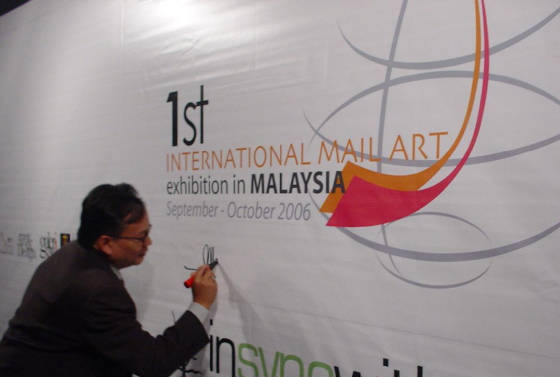

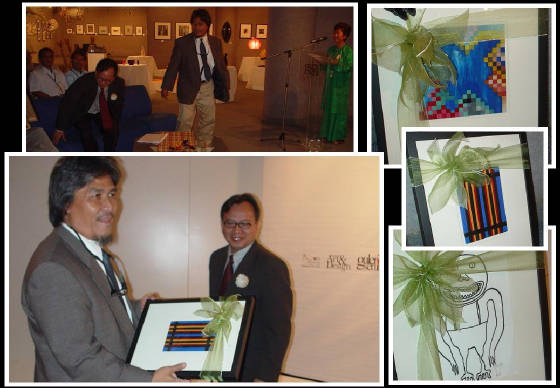
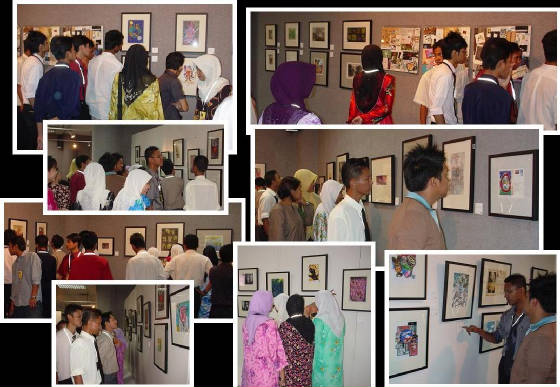
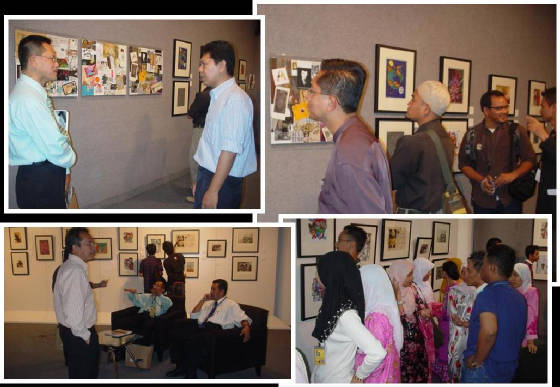

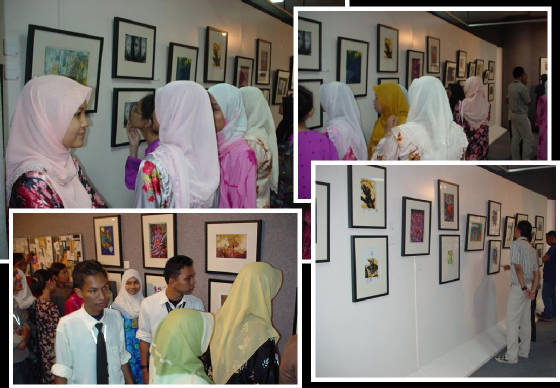
|

